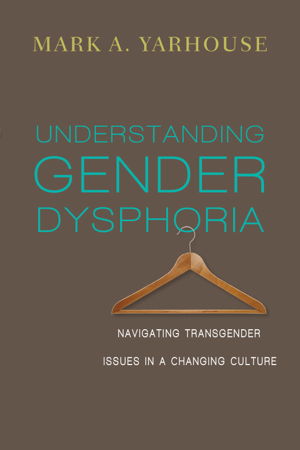What does it mean to be a gendered person? Rushing to the forefront of the conversation about how to be a loving and beloved human being in our society, this question confronts and often confounds us as Christians. In Understanding Gender Dysphoria, Mark Yarhouse helps provide a way forward into the very specific, and still very uncertain, conversation about transgender issues, neither despairing over Christians' ability to discern with confidence how to think and act, nor overlooking the complexity of our experience.

Yarhouse begins, extremely helpfully, with an entire chapter's worth of definitions (including a definition for gender dysphoria [GD]: a felt, distressing "incongruence" between one's gender identity and biological sex [20].) The book is designed for a newcomer to the topic. Yarhouse empowers (and humbles!) his readers with an extensive vocabulary of distinctions most churchgoers may not know existed. For example, a person with GD may not readily identify as transgender; and neither does an experience of GD necessarily include cross-dressing, or homo- or bisexuality (though it may include any or all of these). Persons with GD may see themselves as queer; they may not. They may identify with the LGBTQ community; they may not. It is clear from the beginning that it's not Yarhouse's goal to to press research either into an ill-fitting theological shape or a purely subjective mishmash, but rather to demonstrate that a confident, positive, and relevant Christian response to GD and transgender issues is possible when it is willing to be in deep touch with the concrete complexity of lived experience.
After Yarhouse describes the playing field, he names associated concerns, tells stories, and explains research findings — both what current data can tell us, and what it can't. Other helpful areas he covers include particularly Christian questions, specific ways GD may manifest and how those who experience it may choose to handle it, and documented methods of prevention and treatment.
Then Yarhouse places the theological structure for organizing all this data and story into the understanding and care of persons. He describes throughout the book three approaches to gender that Christians might tend take, which may focus on either original creation (insistence on "integrity"), the fall (GD as "disability"), or glorification (celebration of "diversity"). Yarhouse strongly suggests that a balanced view is missing and needed and calls this the "integrated framework." He provides it as a starting place for holding together a respect for humanity as created male and female along with the realities of universal brokenness and the human need to be loved in community while awaiting "what we shall be." This is a movement of redemption.
Within this theoretical setup, Yarhouse offers real advice. He names the primary character of the church's task as pastoral. This means the church’s response must be irreducibly shaped by experience. Gracefully and gratefully receiving others' stories is vital, and requires active listening. The church helps persons with GD to find meaning in what they've known and to hear God's word for them. The book even provides a suggested guide for these conversations. But if this kind of discernment is not a strongpoint for an individual, Yarhouse insists, Christians at any level of knowledge or experience can assure persons of God's love, and of their own presence alongside them.
Next, the book provides strategies for healing and peacemaking on the individual and institutional levels. This can include providing family restrooms in buildings, helping GD affected persons "disclose" to their loved ones, and continuing a commitment on all sides to discipleship. Yarhouse spends a good deal of time on discipleship especially, and asks what it might mean for persons with GD to be shaped into Christlikeness. For example, pastors, counselors, and Christian friends can help a Christian with GD to discern a minimally invasive program of symptom management which enables them to live both faithfully and peacefully before God. But a disciple with GD may also need to be given freedom to manage their GD in conversation with the church and the Lord without judgment, whether or not their Christian community can always readily understand their choices. The pain of GD, Yarhouse adds, may itself be used by a Christian with GD to intentionally enter more deeply into the suffering and fellowship of Christ. He also addresses the fact that some persons who have already chosen invasive management methods, such as surgery and hormone therapy, cannot turn back the clock on their decision, and may not want to. The church's job, starting from any point in the human journey, is to invite people to come to know Christ, and to walk beside them as they grow in him and learn over time how he loves them, and discern what concrete obedience he requires.
In essence, it seems the present task for the church in responding to transgender issues is the same as for the Christian with gender dysphoria: to seek to bear God's love in complex distress; to patiently do our best with what we know; and to live confident that God will guide those who earnestly seek to live faithfully. Yarhouse's book, an essential guide for pastors, church staff, or laypeople, is a wise and joyful classroom of pastoral care, and a great beginning to walking the terrain of gender and sexuality without losing heart.